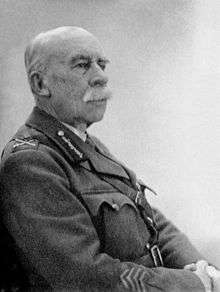Anthony Bowlby
| Sir Anthony Bowlby, Bt | |
|---|---|
 Sir Anthony Bowlby as a Major-General | |
| Born |
10 May 1855 Namur, Belgium |
| Died |
7 April 1929 (aged 73) Lyndhurst, Hampshire |
| Allegiance |
|
| Service/branch |
|
| Years of service |
1899-1900 1914–1918 |
| Rank | Major-General |
| Battles/wars |
Second Boer War First World War |
| Awards | Knight Commander of the Order of the Bath, Knight Commander of the Order of St Michael and St George, Knight Commander of the Royal Victorian Order |
Major-General Sir Anthony Alfred Bowlby, 1st Baronet KCB KCMG KCVO (10 May 1855 – 7 April 1929) was a British Army officer, surgeon and pathologist.[1][2]
Early life
He was born in Namur, Belgium, the son of Thomas William Bowlby (1818–1860), a correspondent to The Times who died in captivity in China. Anthony was educated at Durham School and St Bartholomew's Hospital, London (1876), qualifying as a Member of the Royal College of Surgeons in 1879.[1][2]
Career
In 1880 he was appointed House Surgeon at St Bartholomew's, was promoted to Surgical Registrar to the Hospital and Demonstrator of Practical Surgery in 1884, then to Assistant Surgeon and in 1903 to full Surgeon. During the Second Boer War (1899–1900) he served as a medical officer in South Africa at the Portland Field Hospital, Bloemfontein, after which he was invested as a Companion of the Order of St Michael and St George[1]
He was Surgeon to King Edward VII's Household between 1904 and 1910 and Honorary Surgeon-in-Ordinary to King George V in 1910. He was made a Knight Bachelor in 1911.[1]
He served in France in the First World War as Consulting Surgeon to the Forces, with the rank of Major-General, Army Medical Services and towards the end of the war became Adviser on Surgery for the whole of the British area, Front and Base. His main achievement was the development of Casualty Clearing Stations into quasi hospitals carrying out major surgery.[1]
He served as a Councillor of the Royal College of Surgeons of England from 1904 until 1920, when he became President for three years. He delivered the Bradshaw Lecture in 1915 on the subject of "Wounds in War" and gave the Hunterian Oration in 1919.[1] After serving as President, he was created a baronet, of Manchester Square, in the Baronetage of the United Kingdom. He had been made a Knight Commander of the Order of the Bath in 1919.
Personal life
He died on holiday at Stoney Cross, Lyndhurst, on 7 April 1929, was cremated at Brookwood, and buried at Brooklands Cemetery. He had married Maria Bridget, the daughter of Canon the Hon. Hugh Wynne Mostyn, with whom he had three sons and three daughters. He was succeeded as Baronet by his eldest son, Anthony Hugh.[1]
Honours and awards
- Fellow of the Royal College of Surgeons, 1881
- Knight Bachelor, 1911
- K.C.M.G., 1915
- K.C.V.O., 1916
- K.C.B, 1919
- D.S.M. (U.S.), 1919[3]
- President of the Royal College of Surgeons 1920–23.
- Honorary D.C.L., Durham University, 1923.
He was created 1st Baronet Bowlby, of Manchester Square, Borough of St. Marylebone [U.K.] on 17 July 1923.[2]
Publications
- Surgical Pathology and Morbid Anatomy, 16mo, London, 1887.
- Injuries and Diseases of Nerves and their Surgical Treatment, 8vo, 20 plates. London, 1889; Philadelphia, 1890.
- A Civilian War Hospital, with Cuthbert Sidney Wallace, being an account of the work of the Portland Hospital and of experience of wounds and sickness in South Africa, 1900 (etc.), 8vo, 50 plates, London, 1901.
References
- 1 2 3 4 5 6 7 "Bowlby, Sir Anthony Alfred (1855–1929)". Royal College of Surgeons. Retrieved 23 July 2013.
- 1 2 3 Sir Anthony Alfred Bowlby, 1st Bt. Thepeerage.com. Retrieved on 5 June 2014.
- ↑ "British Medical Officers Decorated". Journal of the American Medical Association. 73 (19): 1453. 8 November 1919. doi:10.1001/jama.1919.02610450049021.
| Baronetage of the United Kingdom | ||
|---|---|---|
| Preceded by New creation |
Baronet (of Manchester Square) 1923–1929 |
Succeeded by Anthony Hugh Bowlby |